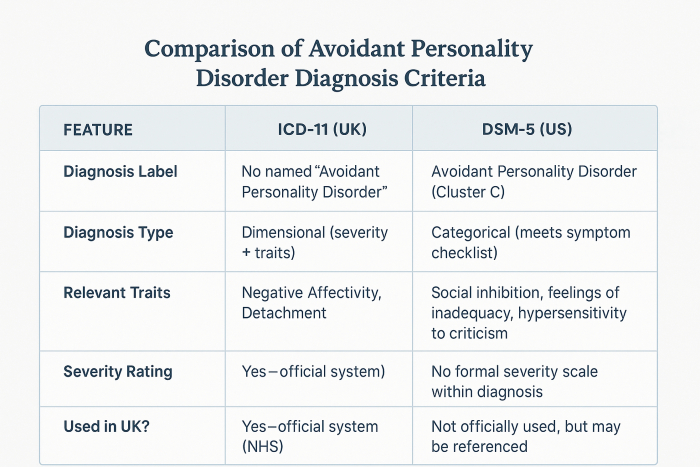
When searching for Avoidant Personality Disorder (AvPD) UK diagnosis criteria, it can be confusing to navigate the different systems professionals use. Terms like ICD-11 and DSM-5 may come up, and it’s clear that the UK and the US sometimes use different language for the same condition. This post breaks it all down: how AvPD is diagnosed in the UK, how it compares to the American system, and what criteria are actually used.
Diagnosis Of Avoidant Personality Disorder In The UK
In the UK, mental health professionals diagnose personality disorders — including AvPD — using the ICD-11 (International Classification of Diseases, 11th Revision), published by the World Health Organization (WHO). This is the standard classification system used by the NHS and most clinical services in the UK.
By contrast, the DSM-5 (Diagnostic and Statistical Manual of Mental Disorders, Fifth Edition), published by the American Psychiatric Association, is used primarily in the United States.
Importantly, the ICD-11 does not list AvPD as a separate diagnosis, while the DSM-5 does. Instead, the ICD-11 uses a dimensional model based on traits and severity.
Who Can Diagnose A Personality Disorder In The UK?
In the UK, a personality disorder diagnosis is typically made by a qualified mental health professional within the NHS or a registered private practice. These professionals must have specialist training and experience in mental health assessment and often work as part of a multidisciplinary team.
Professionals Who Can Diagnose A Personality Disorder Include:
- Consultant Psychiatrists – Medical doctors who specialize in mental health. They are the most common professionals to formally diagnose personality disorders, especially within NHS services.
- Clinical Psychologists – Trained to assess and treat a range of psychological conditions, including personality disorders. They often use structured interviews and psychometric tools to support diagnosis.
- Specialist Mental Health Teams – These may include community psychiatric nurses (CPNs), social workers, and occupational therapists working under psychiatric supervision. While they may contribute to the assessment, the final diagnosis usually comes from a psychiatrist or psychologist.
- GPs – While a GP may suspect a personality disorder and make a referral, they typically do not provide a formal diagnosis.
To receive a diagnosis, a person is usually referred to a Community Mental Health Team (CMHT) or a Personality Disorder Service. The process includes:
- A full psychiatric history
- Interviews with the individual (and sometimes close family)
- Use of structured diagnostic tools
- Observation of long-term patterns of thoughts, feelings, and behavior
ICD-11 Criteria: The UK Approach
The ICD-11 defines personality disorders using a dimensional model. Here’s how AvPD-related traits are captured:
1. Core Diagnosis: Personality Disorder
The person must show enduring disturbances in:
- Self-functioning (e.g., unstable identity, low self-worth)
- Interpersonal functioning (e.g., difficulty forming close relationships, avoiding intimacy)
These disturbances must be:
- Persistent and pervasive
- Present since adolescence or early adulthood
- Not better explained by another mental disorder or external factors
2. Severity Level
The disorder is classified as:
- Mild
- Moderate
- Severe
This is based on the impact on life, relationships, and day-to-day functioning.
3. Trait Domain Specifiers
Rather than naming “Avoidant Personality Disorder,” the ICD-11 uses traits. For AvPD-like patterns, the relevant domains are:
- Negative Affectivity: anxiousness, low self-esteem, shame, emotional sensitivity.
- Detachment: social withdrawal, intimacy avoidance, interpersonal coldness.
For example, someone who would be considered to have AvPD under DSM-5 might receive an ICD-11 diagnosis like:
“Personality disorder, moderate severity, with prominent traits of Negative Affectivity and Detachment.”
DSM-5 Criteria: The US Approach
The DSM-5 offers a categorical diagnosis of Avoidant Personality Disorder under Cluster C.
To be diagnosed under DSM-5, a person must meet at least 4 of the following 7 criteria:
1. Avoids occupational activities involving interpersonal contact due to fears of criticism or rejection.
2. Unwilling to get involved unless certain of being liked.
3. Shows restraint in intimate relationships for fear of ridicule or shame.
4. Is preoccupied with being criticized or rejected in social settings.
5. Is inhibited in new relationships due to feelings of inadequacy.
6. Views self as socially inept, unappealing, or inferior.
7. Is unusually reluctant to take risks or try new activities for fear of embarrassment.
While not officially used in UK diagnoses, UK clinicians may reference DSM-5 criteria informally for additional insight.

Why This Matters
Understanding the Avoidant Personality Disorder UK diagnosis criteria is important for anyone navigating the mental health system in Britain. Whether you’re seeking a diagnosis, supporting someone else, or just trying to understand your own experiences, knowing the difference between the ICD-11 and DSM-5 can clarify a lot of confusion. Even though “Avoidant Personality Disorder” as a label isn’t used officially in the UK system anymore, the pattern of behavior and emotional experience absolutely is recognized – just under a more flexible, trait-based model.
Final Thoughts If you’re trying to get help for AvPD-like symptoms in the UK, don’t worry that the name has disappeared — the experiences of emotional vulnerability, avoidance, and fear of rejection are still taken seriously under the Avoidant Personality Disorder UK diagnosis criteria may look different on paper, but the heart of the condition is still recognized and treatable.
 Further Reading And Resources
Further Reading And Resources
MIND – Diagnosing personality Disorder
General MIND overview of diagnosing personality disorders
ICD-11 Clinical Descriptions
World Health Organization
https://icd.who.int/
DSM-5
American Psychiatric Association (2013)
Diagnostic and Statistical Manual of Mental Disorders, Fifth Edition
Bach, B., & First, M. B. (2018)
Application of the ICD-11 classification of personality disorders.
BMC Psychiatry, 18, 351.
Tyrer, P., & Mulder, R. (2020)
ICD-11 and the future of personality disorder classification.
Personality and Mental Health, 14(1), 3–5.